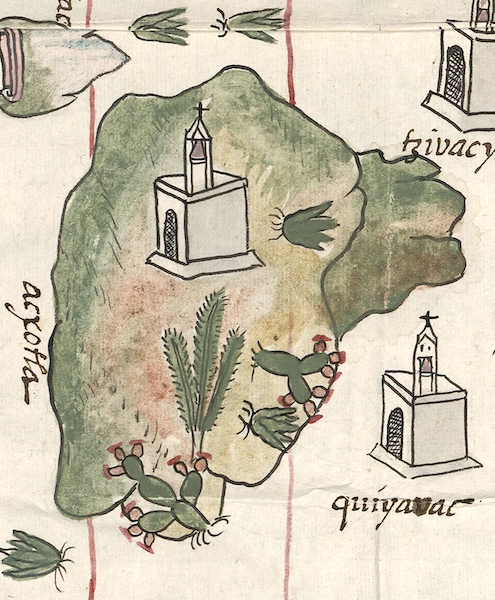Acxotla (CmpRG)
This is a compound glyph for the place known as Acxotla ("Place of Abundance of the Acxoyatl Plant"). Its main element is a three-branched plant with a ritual significance. This plant and the larger glyph of which it is a part appears on the map included with the 1580 Relación Geográfica de Cempoala (originally, Cempohuallan, in what is now the state of Hidalgo, Mexico). The plant element is superimposed on a naturalistic hill or mountain (tepetl) which also features a drawing of a church, two signs of Spanish cultural influence. These two figures serve as semantic indicators that Acxotla is an inhabited place. The place name consists of the apocopated root of the noun (acxoyatl), a fir-like plant, and the locative -tla, “abounds in.” The plant’s three fronds or branches are green with details in black to indicate its foliage. A short trunk is outlined in black. The glyph faces the viewer in an upright position. The tepetl is shaded in browns and green. It supports other foliage that is not directly related to the glyph. The church is outlined in black, has an arched doorway with a mesh design in it, and a bell tower topped with a cross and with a tan-colored bell. The 3/4 view of the church suggests European stylistic influence.
Robert Haskett
Acxotla was a subject town of the cabecera (head town) of Tzacuala, one of four such principal communities making up the municipality of (what is now spelled as) Zempoala. The plant (acxoyatl), with its green branches, is described and pictured in Dr. Francisco Hernández’s sixteenth-century natural history, where it is characterized as having boughs something like a pine and produces an aromatic oil. Other flora, such as the nopal cacti and maguey plants pictured on the tepetl of the compound glyph, indicate typical plants in the region (see the historical contextualizing image). For more information about the Relación, see Mundy, Barbara E., “Mapping Babel: A Sixteenth-Century Indigenous Map from Mexico,” The Appendix, 1:4 (October 2013), and the same author’s book, The Mapping of New Spain: Indigenous Cartography and the Maps of the Relaciones Geográficas (Chicago and London: The University of Chicago Press, 1996).
In this collection there are glyphs for the place name Acxotlan, which this town could also be named, if the final "n" has inadvertently dropped away. This would change the place of *abundance* to being *near* where such trees grow.
Robert Haskett
acxotla
Acxotla
Robert Haskett
1580
Robert Haskett
Along with the Acxoyatl and the hill (or rather amorphous tepetl, which serves as a silent locative), we are counting the church in the count of elements, too, for it seems to play the semantic role of clarifying that Acxotla is a pueblo.
plants, las plantas, firs, los abetos, churches, las iglesias, hills, mountains, los cerros, Acxotlan, nombres de lugares

acxoya(tl), fir branches , https://nahuatl.wired-humanities.org/content/acxoyatl
-tla, locative compounding element conveying the sense of abundance, https://nahuatl.wired-humanities.org/content/tla-1
El Lugar de Muchos Acxoyates
Stephanie Wood
Relación de Cempoala - University of Texas Libraries Collections. 1580-11-01. https://collections.lib.utexas.edu/catalog/utblac:f87917e2-e3c9-4eb2-a83...
Materials that are in the public domain (such as most of the maps in the PCL Map Collection) are not copyrighted, and no permission is needed to copy them. You may download them and use them as you wish. The image appears here courtesy of the University of Texas Libraries, The University of Texas at Austin. If you do publish anything from this database, please cite the Visual Lexicon of Aztec Hieroglyphs.



